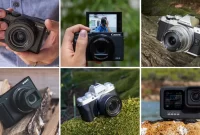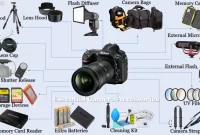Are you in the market for a new camera? With so many options available, it can be overwhelming to choose the perfect one. In this article, we will explore the top features that you should look for when making your next camera purchase. From image quality to lens options, we’ve got you covered.
Image Sensor and Megapixels
When considering the purchase of a new camera, there are several top features that you should look for. One of the most important features to consider is the image sensor and megapixels.
The image sensor is the heart of any camera. It is responsible for capturing the light that enters the camera and converting it into a digital image. A larger image sensor will generally produce better image quality, especially in low-light conditions. So, when choosing a camera, it’s advisable to opt for a larger sensor size.
Megapixels, on the other hand, refer to the resolution of the camera. It determines the level of detail that the camera can capture. While it’s tempting to believe that more megapixels always mean better image quality, this is not entirely true. Higher megapixel counts are beneficial if you plan on printing large photos or cropping images extensively. However, for most casual photographers, a camera with around 12-24 megapixels will suffice.
It’s also important to note that the image sensor and megapixels alone do not guarantee superior image quality. Other factors like the lens quality, image processing capabilities, and the camera’s overall build play a significant role as well.
So, when searching for your next camera, be sure to pay attention to the image sensor and megapixels, but remember to evaluate the overall package as well. Consider your photography needs, budget, and other features like lens selection, autofocus capabilities, and video recording capabilities to make an informed decision.
Auto-Focus System and Tracking Performance
When it comes to choosing a new camera, one of the most important features to consider is the auto-focus system and tracking performance. This feature determines how well your camera can focus on moving subjects and keep them in sharp focus throughout the shot.
An advanced auto-focus system enables you to capture action shots, sports events, or wildlife in motion with ease and precision. Look for a camera that offers fast and accurate focus, as well as a high number of focus points spread across the frame.
A camera with reliable tracking performance will keep your subject in focus even when it moves across the frame or changes its speed. This is especially useful for capturing fast-moving subjects like athletes or animals. The camera should be able to continuously track the subject and adjust its focus automatically.
In addition to the number of focus points and tracking ability, consider the focus modes available in the camera. Some cameras offer a variety of focus modes such as single-point, zone, or wide-area depending on your shooting needs. This flexibility in focus selection can greatly enhance your photography experience.
Whether you are a professional photographer or an enthusiast, a camera with a reliable auto-focus system and excellent tracking performance is essential for capturing those decisive moments. Make sure to pay attention to this feature when making your next camera purchase.
ISO Range and Low-Light Capability
When looking to purchase your next camera, one of the top features to consider is its ISO range and low-light capability. These factors play a crucial role in determining the camera’s ability to capture clear and sharp images in various lighting conditions.
A camera’s ISO range indicates its sensitivity to light. The wider the ISO range, the better the camera performs in low-light situations. A vast ISO range allows you to adjust the sensitivity to match the available light, resulting in less noise and more detailed images.
Low-light capability refers to how well the camera handles challenging lighting conditions. Cameras with excellent low-light capability have larger pixel sizes and advanced noise reduction technology, enabling them to capture stunning images even in dimly lit environments.
Whether you are shooting in a dimly lit room, capturing nighttime scenes, or taking photos in challenging outdoor conditions, a camera with a wide ISO range and impressive low-light capability will ensure you can achieve outstanding results.
Video Recording Features and Resolutions
When looking for a new camera, it’s important to consider its video recording features and resolutions. These features can greatly enhance your video production and provide you with high-quality footage.
1. Resolution: One of the key factors to consider is the resolution of the camera. Higher resolution cameras allow for sharper and more detailed videos. The two most common resolutions are Full HD (1080p) and 4K. 4K resolution offers incredible clarity and is becoming increasingly popular.
2. Frame Rate: Another important consideration is the camera’s frame rate. The frame rate determines how many individual frames are captured per second. Higher frame rates result in smoother motion, which is ideal for capturing fast-moving subjects or creating slow-motion effects.
3. Image Stabilization: Video footage can easily be ruined by shaky or unstable movements. Look for cameras with built-in image stabilization technology, which compensates for motion and ensures smoother, more professional-looking videos.
4. Manual Controls: For more advanced videographers, having manual control options is essential. This allows you to have full creative control over the exposure, aperture, shutter speed, ISO, and white balance settings, resulting in more professional-looking videos.
5. Audio Input: While the video quality is crucial, audio quality should not be overlooked. Consider a camera that offers an external audio input or a microphone jack, enabling you to connect external microphones for better sound recording.
6. Autofocus: Smooth and accurate autofocus is important for capturing sharp and well-focused videos. Look for cameras with advanced autofocus systems that track subjects and adjust focus quickly and accurately.
7. Connectivity Options: Consider cameras that provide connectivity options such as Wi-Fi or Bluetooth. These features allow you to transfer your videos wirelessly, control the camera remotely, or even livestream your footage.
By considering these video recording features and resolutions, you can select a camera that meets your specific needs and helps you create exceptional videos.
Conclusion
In making your next camera purchase, it is essential to consider the top features that will enhance your photography experience. Look for advanced autofocus capabilities, high-resolution sensors, versatile lens options, robust image stabilization, and connectivity features. These key features will help you capture stunning images and make the most of your camera investment.




